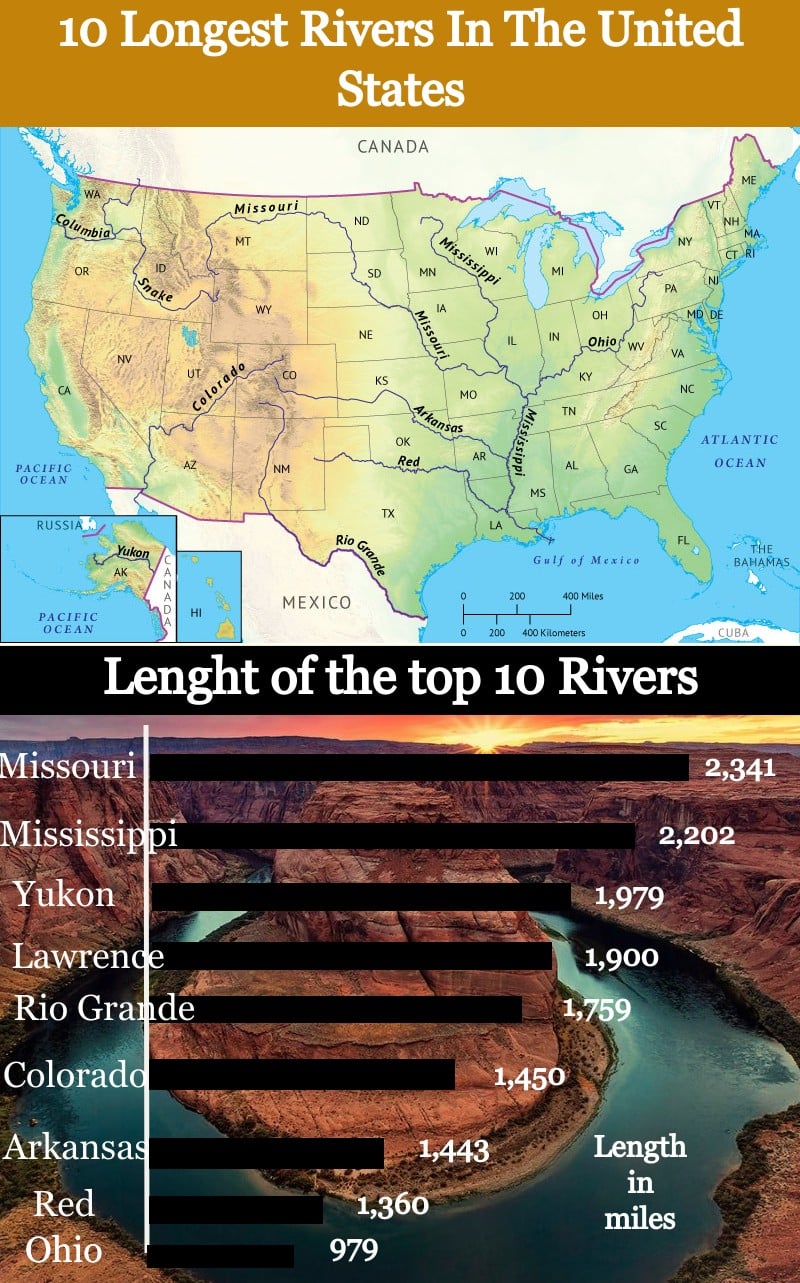Longest Rivers in the United States
The United States is a large, wide-reaching nation with a type of terrain, landscapes, and ecosystems. The United States of America has roughly 250,000 rivers, with accommodation of approximately 3,500,000 miles of rivers ways.
Rivers are the lifeblood of our planet, shaping landscapes and providing invaluable resources for both humans and wildlife. The United States boasts an impressive network of rivers, with diverse ecosystems and awe-inspiring lengths. In this article, we delve into the top 10 longest rivers in the US, exploring their magnificence and highlighting their significance
Largest Rivers in the United States
Here the list gives below of the longest rivers in the USA in the ranking of their length.
1. Missouri River (Length: 2,341 miles)
What is the longest river in USA?
The mighty Missouri River claims the title of the longest river in the United States. Originating from the confluence of the Jefferson, Madison, and Gallatin rivers in Montana, it carves its path through the heartland of America before merging with the Mississippi River in Missouri. The Missouri River played a pivotal role in the westward expansion of the nation, serving as a vital transportation and trade route.
2. Mississippi River (Length: 2,320 miles)
Renowned as the “Father of Waters,” the Mississippi River stands as an icon of American geography and culture. Flowing through ten states, from Minnesota to the Gulf of Mexico, the Mississippi River has been immortalized in literature, music, and folklore. It remains a vital waterway for commerce, transportation, and recreation.
3. Yukon River (Length: 1,979 miles)
Stretching across Alaska and the Yukon Territory in Canada, the Yukon River ranks as the third longest river in the United States. It originates in British Columbia’s Coast Mountains and traverses through pristine wilderness before meeting the Bering Sea. The river has significant cultural importance to the native populations who have relied on its resources for centuries.
4. Rio Grande (Length: 1,759 miles)
Forming a natural border between the United States and Mexico, the Rio Grande flows through Colorado, New Mexico, Texas, and forms the southern boundary of Texas before emptying into the Gulf of Mexico. This river has a rich history and cultural significance, influencing the development of the American Southwest and serving as a source of water for agricultural and domestic use.
5. Colorado River (Length: 1,450 miles)
The Colorado River, with its mesmerizing canyons and dramatic landscapes, has carved its way through seven US states and two Mexican states. Originating in the Rocky Mountains of Colorado, the river meanders southwest, reaching its end at the Gulf of California. The Colorado River’s water resources are crucial for irrigation, hydroelectric power generation, and recreational activities.
6. Arkansas River (Length: 1,460 miles)
Flowing through the heartland of America, the Arkansas River stretches from Colorado through Kansas, Oklahoma, and Arkansas before joining the Mississippi River. It has played a significant role in the region’s development, serving as a trade route during the frontier era and providing water for agriculture and industry.
7. Columbia River (Length: 1,243 miles)
The Columbia River winds its way through the Pacific Northwest, starting in British Columbia, Canada, and flowing through Washington and Oregon before emptying into the Pacific Ocean. It is a vital source of hydroelectric power and supports diverse ecosystems. The Columbia River Gorge, with its breathtaking scenery, attracts visitors from around the world.
8. Red River (Length: 1,360 miles)
The Red River acts as a natural border between Texas and Oklahoma before flowing through Arkansas and Louisiana into the Mississippi River. It played a crucial role in the history of the southern United States, serving as a trade and transportation route. The river derives its name from its reddish-colored sediment.
9. Ohio River (Length: 981 miles)
Originating at the confluence of the Allegheny and Monongahela rivers in Pittsburgh, Pennsylvania, the Ohio River carves its path through six states before merging with the Mississippi River. The Ohio River has been integral to the development of the Midwest and was a significant trade route during the early days of American settlement.
10. Tennessee River (Length: 652 miles)
The Tennessee River flows through Tennessee, Alabama, Mississippi, and Kentucky, offering scenic beauty and recreational opportunities. The river is known for its navigable channels and is harnessed for hydroelectric power generation, supporting the region’s industries and communities.
Conclusion
The United States is blessed with an impressive array of rivers, each with its own unique charm and significance. From the grandeur of the Missouri and Mississippi rivers to the untamed beauty of the Yukon River, these waterways have shaped the landscapes they pass through and played a vital role in the nation’s history, economy, and culture. As stewards of these natural treasures, it is our responsibility to appreciate and protect these remarkable rivers for generations to come.

